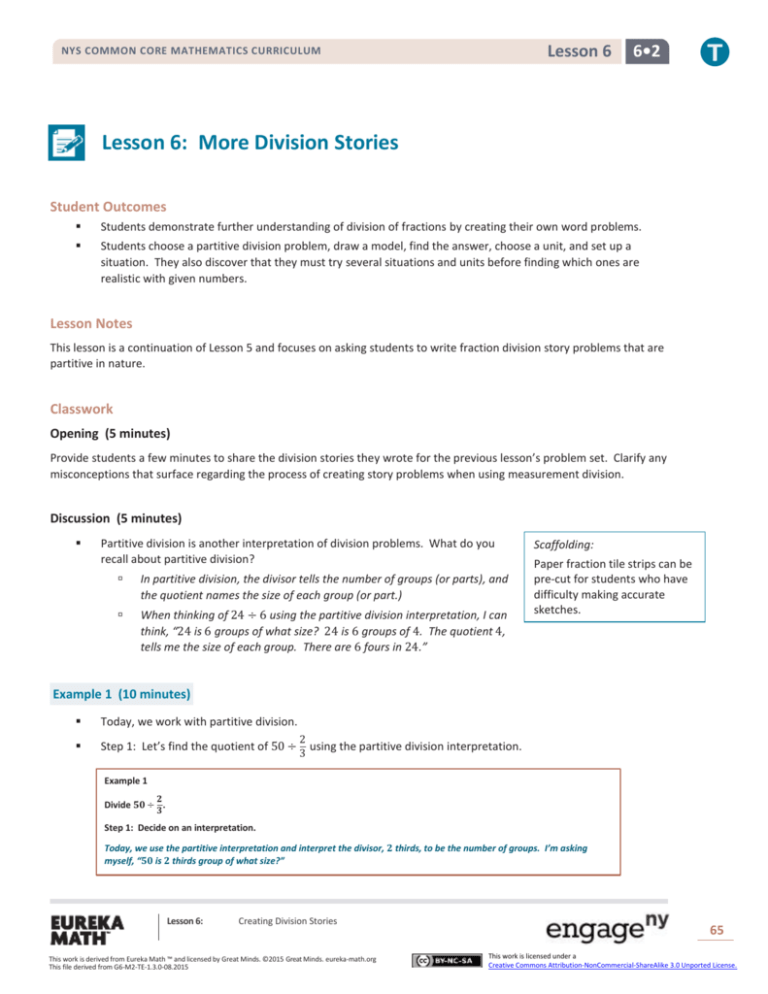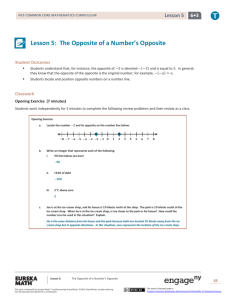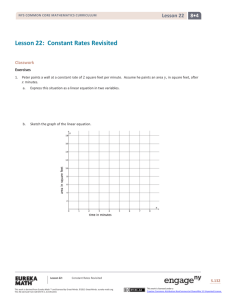Teacher Version
advertisement

Lesson 6 NYS COMMON CORE MATHEMATICS CURRICULUM 6•2 Lesson 6: More Division Stories Student Outcomes Students demonstrate further understanding of division of fractions by creating their own word problems. Students choose a partitive division problem, draw a model, find the answer, choose a unit, and set up a situation. They also discover that they must try several situations and units before finding which ones are realistic with given numbers. Lesson Notes This lesson is a continuation of Lesson 5 and focuses on asking students to write fraction division story problems that are partitive in nature. Classwork Opening (5 minutes) Provide students a few minutes to share the division stories they wrote for the previous lesson’s problem set. Clarify any misconceptions that surface regarding the process of creating story problems when using measurement division. Discussion (5 minutes) Partitive division is another interpretation of division problems. What do you recall about partitive division? In partitive division, the divisor tells the number of groups (or parts), and the quotient names the size of each group (or part.) When thinking of 24 ÷ 6 using the partitive division interpretation, I can think, “24 is 6 groups of what size? 24 is 6 groups of 4. The quotient 4, tells me the size of each group. There are 6 fours in 24.” Scaffolding: Paper fraction tile strips can be pre-cut for students who have difficulty making accurate sketches. Example 1 (10 minutes) Today, we work with partitive division. Step 1: Let’s find the quotient of 50 ÷ 2 using the partitive division interpretation. 3 Example 1 𝟐 𝟑 Divide 𝟓𝟎 ÷ . Step 1: Decide on an interpretation. Today, we use the partitive interpretation and interpret the divisor, 𝟐 thirds, to be the number of groups. I’m asking myself, “𝟓𝟎 is 𝟐 thirds group of what size?” Lesson 6: Creating Division Stories This work is derived from Eureka Math ™ and licensed by Great Minds. ©2015 Great Minds. eureka-math.org This file derived from G6-M2-TE-1.3.0-08.2015 65 This work is licensed under a Creative Commons Attribution-NonCommercial-ShareAlike 3.0 Unported License. 6•2 Lesson 6 NYS COMMON CORE MATHEMATICS CURRICULUM Step 2: Draw a model. How many units do we draw? How do you know? The denominator of the fraction tells us we are using thirds. We need 3 units in in the tape diagram. Step 2: Draw a model. The 50 represents how many of the units? 50 is 2 thirds of the whole, so it represents 2 of the units of 1 third. Step 2: Draw a model. 𝟓𝟎 𝟐𝟓 𝟐𝟓 ? 2 2 3 Step 3: Find the answer. In the partitive interpretation, 50 ÷ means 50 is of some number. By looking at 3 our tape diagram, we can see that 2 units are equal to 50, so we can divide by 2 to find that the value of 1 unit is 25. Then, in order to find the value of 3 units, we can multiply 3 × 25 to get 75. 2 Encourage students to recall the pattern they saw in Lesson 2. When dividing 50 by , we can find the quotient by 3 dividing by 2 and then multiplying by 3. Step 3: Find the answer. 𝟐 units = 𝟓𝟎 𝟏 unit = 𝟓𝟎 ÷ 𝟐 = 𝟐𝟓 𝟑 units = 𝟑 × 𝟐𝟓 = 𝟕𝟓 Step 4: Choose a unit. Answers will vary, but dollars will be used throughout the discussion below. Step 5: Set up a situation based upon the model. Answers will vary, but there is a story problem provided in the discussion. Now that we have the answer, we can move on to the fourth step, choosing a unit. Money units are often convenient for making word problems. Using dollars as the unit, we are looking for a situation where 2 3 of some dollar amount is $50. Lesson 6: Creating Division Stories This work is derived from Eureka Math ™ and licensed by Great Minds. ©2015 Great Minds. eureka-math.org This file derived from G6-M2-TE-1.3.0-08.2015 66 This work is licensed under a Creative Commons Attribution-NonCommercial-ShareAlike 3.0 Unported License. Lesson 6 NYS COMMON CORE MATHEMATICS CURRICULUM 6•2 Step 5 is to set up a situation based upon the model. Remember that this means writing a story problem that includes all of the information necessary to solve it and that is also interesting, realistic, short, and clear. It may take several attempts before you find a story that works well with the given dividend and divisor. Spending money gives a “before and after” word problem. We are looking for a situation where of some 2 3 greater dollar amount is $50. One story problem that might go well with these numbers is the following: Adam spent $50 on a new 2 graphing calculator. This was of his money. How much money did he start with? 3 Exercise 1 (5 minutes) Allow students to work with a partner to create the story problem. Also, take time to share and discuss their work. Exercise 1 Using the same dividend and divisor, work with a partner to create your own story problem. You may use the same unit, dollars, but your situation must be unique. You could try another unit, such as miles, if you prefer. Possible story problems: Ronaldo has ridden 𝟓𝟎 miles during his bicycle race and is 1. Samantha used 𝟓𝟎 tickets ( 2. 𝟐 𝟑 𝟐 𝟑 of the way to the finish line. How long is the race? of her total) to trade for a kewpie doll at the fair. How many tickets did she start with? Example 2 (10 minutes) Step 1: Let’s find the quotient of 1 2 ÷ 3 4 using the partitive division interpretation. Example 2 Divide 𝟏 𝟐 𝟑 ÷ . 𝟒 Step 1: Decide on an interpretation. Today, we use the partitive interpretation and interpret the divisor, 𝟑 fourths, to be the number of groups. I’m asking myself, “𝟏 half is 𝟑 fourths of what number?” Step 2: Draw a model. How many units do we draw? How do you know? The denominator of the fraction tells us we are using fourths. We need 4 units in in the tape diagram. Step 2: Draw a model. Lesson 6: Creating Division Stories This work is derived from Eureka Math ™ and licensed by Great Minds. ©2015 Great Minds. eureka-math.org This file derived from G6-M2-TE-1.3.0-08.2015 67 This work is licensed under a Creative Commons Attribution-NonCommercial-ShareAlike 3.0 Unported License. Lesson 6 NYS COMMON CORE MATHEMATICS CURRICULUM 6•2 1 half represents how many of the units? 1 2 is 3 fourths, so it represents 3 of the units of 1 fourth. Step 2: Draw a model. 𝟏 𝟐 𝟏 𝟔 𝟏 𝟔 𝟏 𝟔 ? Step 3: Find the answer. In the partitive interpretation, 1 2 1 ÷ 3 4 3 means 1 half is of some number. By looking 4 at our tape diagram, we can see that 3 units are equal to , so we can divide by 3 to find that the value of 1 2 1 unit is . Then, in order to find the value of 4 units, we can multiply 4 × (1 sixth) to get 4 sixths. 6 Step 3: Find the answer. 𝟑 units = 𝟏 unit = 𝟏 𝟐 𝟏 𝟐 ÷𝟑= 𝟏 𝟑 of 𝟏 𝟐 = 𝟏 𝟔 𝟒 units = 𝟒 × 𝟏 sixth = 𝟒 sixths = 𝟒 𝟔 Step 4: Choose a unit. Answers will vary. Step 5: Set up a situation based upon the model. Answers will vary. Now that we have the answer, we can move on to the fourth step, choosing a unit. In this example, both the dividend and the quotient are a fraction. Therefore, the unit we choose has to be such that 1 2 4 and both make 6 sense. Time (in hours), distance (in feet), and eggs (in dozens) are good options since both halves and sixths are identifiable parts of an hour, a foot, and a dozen. Step 5: Set up a situation based upon the model. Remember that this means writing a story problem that includes all of the information necessary to solve it and that is interesting, realistic, short, and clear. It may take several attempts before you find a story that works well with the given dividend and divisor. One story problem that might go well with these numbers is the following: After traveling for a half hour, 3 Scott completed of his commute. How long is commute? 4 Lesson 6: Creating Division Stories This work is derived from Eureka Math ™ and licensed by Great Minds. ©2015 Great Minds. eureka-math.org This file derived from G6-M2-TE-1.3.0-08.2015 68 This work is licensed under a Creative Commons Attribution-NonCommercial-ShareAlike 3.0 Unported License. Lesson 6 NYS COMMON CORE MATHEMATICS CURRICULUM 6•2 Exercise 2 (5 minutes) Allow students to work with a partner to create the story problem. Also, take time to share and discuss their work. Exercise 2 Using the same dividend and divisor, work with a partner to create your own story problem. Try a different unit. Possible story problems: 1. Daryl completed 𝟑 fourths of his homework in a half hour. How long does it take Daryl to complete all of his homework? 2. A snail saw food sitting a distance away. After traveling for a half foot, a snail had covered 𝟑 𝟒 the distance. How far away was the food? Closing (3 minutes) How did we extend our work with division with fractions in this lesson? We took an answer to a partitive division problem, chose a unit, and then thought of a story problem that would fit it. What were your biggest challenges when writing story problems involving division with fractions? Accept all answers. Exit Ticket (2 minutes) Lesson 6: Creating Division Stories This work is derived from Eureka Math ™ and licensed by Great Minds. ©2015 Great Minds. eureka-math.org This file derived from G6-M2-TE-1.3.0-08.2015 69 This work is licensed under a Creative Commons Attribution-NonCommercial-ShareAlike 3.0 Unported License. Lesson 6 NYS COMMON CORE MATHEMATICS CURRICULUM Name 6•2 Date Lesson 6: More Division Stories Exit Ticket 5 8 Write a story problem using the partitive interpretation of division for the following: 25 ÷ = 40. 25 ? Lesson 6: Creating Division Stories This work is derived from Eureka Math ™ and licensed by Great Minds. ©2015 Great Minds. eureka-math.org This file derived from G6-M2-TE-1.3.0-08.2015 70 This work is licensed under a Creative Commons Attribution-NonCommercial-ShareAlike 3.0 Unported License. Lesson 6 NYS COMMON CORE MATHEMATICS CURRICULUM 6•2 Exit Ticket Sample Solutions Write a story problem using the partitive interpretation of division for the following: 𝟐𝟓 ÷ 𝟓 = 𝟒𝟎. 𝟖 𝟐𝟓 ? Zolanda spent 𝟓 𝟖 of her class period, or 𝟐𝟓 minutes, taking notes. How long was the class period? (Accept any other reasonable story problem showing 𝟐𝟓 ÷ 𝟓 = 𝟒𝟎.) 𝟖 Problem Set Sample Solutions Solve. 1. 𝟏𝟓 𝟏𝟔 is 𝟏 sixteenth groups of what size? 𝟏𝟓 sixteenths ÷ 𝟏 sixteenth = 𝟏𝟓. The size of the group is 𝟏𝟓. 2. 𝟕 𝟖 𝟏 teaspoons is groups of what size? 𝟒 𝟕 eighths ÷ 𝟐 eighths = 3. 𝟕 𝟏 𝟏 = 𝟑 . The size of the group is 𝟑 . 𝟐 𝟐 𝟐 A 𝟒-cup container of food is 𝟐 𝟑 groups of what size? 𝟏𝟐 thirds ÷ 𝟐 thirds = 𝟔. The size of the group is 𝟔. 4. 𝟑 𝟒 Write a partitive division story problem for 𝟔 ÷ . Answers will vary. 5. Write a partitive division story problem for 𝟓 𝟏𝟐 𝟏 ÷ . 𝟔 Answers will vary. 6. Fill in the blank to complete the equation. Then, find the quotient, and draw a model to support your solution. a. 𝟏 𝟒 𝟏 𝟒 ÷𝟕= ÷𝟕= 𝟏 𝟏 □ of 𝟒 𝟏 𝟕 of Lesson 6: 𝟏 𝟒 = 𝟏 𝟐𝟖 Creating Division Stories This work is derived from Eureka Math ™ and licensed by Great Minds. ©2015 Great Minds. eureka-math.org This file derived from G6-M2-TE-1.3.0-08.2015 71 This work is licensed under a Creative Commons Attribution-NonCommercial-ShareAlike 3.0 Unported License. NYS COMMON CORE MATHEMATICS CURRICULUM 𝟓 b. 𝟔 𝟓 𝟔 7. ÷𝟒= ÷𝟒= 𝟏 Lesson 6 6•2 𝟓 □ of 𝟔 𝟏 of 𝟒 𝟓 𝟔 = 𝟓 𝟐𝟒 𝟑 There is of a pie left. If 𝟒 friends wanted to share the pie equally, how much would each friend receive? 𝟓 𝟑 𝟑 𝟏 𝟑 ÷𝟒 = × = 𝟓 𝟓 𝟒 𝟐𝟎 Each friend would receive 8. 𝟑 𝟐𝟎 of the pie. 𝟑 In two hours, Holden completed of his race. How long will it take Holden to complete the entire race? 𝟒 𝟐÷ 𝟑 𝟖 𝟐 = 𝟖 fourths ÷ 𝟑 fourths = = 𝟐 𝟒 𝟑 𝟑 𝟐 𝟑 It will take Holden 𝟐 hours to complete the race. 9. 𝟏 Sam cleaned of his house in 𝟓𝟎 minutes. How many hours will it take him to clean his entire house? 𝟑 𝟓𝟎 minutes= 𝟓 𝟔 ÷ 𝟏 𝟑 𝟏 hour 𝟓 = hours 𝟔𝟎 minutes 𝟔 = 𝟓 sixths ÷ 𝟐 sixths = 𝟓 𝟏 =𝟐 𝟐 𝟐 𝟏 𝟐 It will take Sam 𝟐 hours to clean his entire house. 𝟓 10. It took Mario 𝟏𝟎 months to beat of the levels on his new video game. How many years will it take for Mario to 𝟖 beat all the levels? 𝟏𝟎 months= 𝟏 year 𝟏𝟎 𝟓 = years= years 𝟏𝟐 months 𝟏𝟐 𝟔 𝟓 𝟓 𝟐𝟎 𝟏𝟓 𝟐𝟎 𝟏 ÷ = ÷ = =𝟏 𝟔 𝟖 𝟐𝟒 𝟐𝟒 𝟏𝟓 𝟑 𝟏 𝟑 Mario will need 𝟏 years to beat all the levels. 11. A recipe calls for 𝟏 𝟏 𝟏 cups of sugar. Marley only has measuring cups that measure cup. How many times will 𝟐 𝟒 Marley have to fill the measuring cup? 𝟏 𝟏 𝟑 𝟏 𝟔 𝟏 𝟏 ÷ = ÷ = ÷ =𝟔 𝟐 𝟒 𝟐 𝟒 𝟒 𝟒 Marley will have to use the measuring cup 𝟔 times. Lesson 6: Creating Division Stories This work is derived from Eureka Math ™ and licensed by Great Minds. ©2015 Great Minds. eureka-math.org This file derived from G6-M2-TE-1.3.0-08.2015 72 This work is licensed under a Creative Commons Attribution-NonCommercial-ShareAlike 3.0 Unported License.









